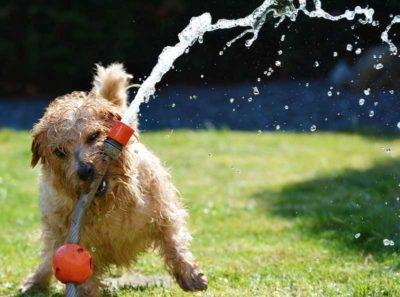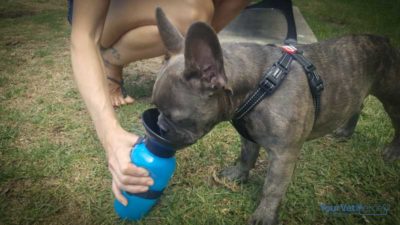Heat Stroke In Dogs & Cats: Signs, Treatment & Prevention
Heat stress in an animal occurs when its body can’t dissipate heat and its core temperature increases above normal.
When the weather is super hot or there is very high humidity we need to recognise the signs of heatstroke/heat stress in dogs, cats and other animals as disaster can happen all too quickly.
Please be extra vigilant as heat stress kills….and it doesn’t take long.
In this article, we explain how to keep your pets safe from heat stress and also how to recognise signs of heat stress so that you can act quickly.

[easy-social-share]
Quick Tips To Help Your Pets Stay Cool
-
- Provide shade/access to water at ALL times
- Walk dogs, exercise horses first thing in the morning at dawn or in the evening at dusk. DO NOT EXERCISE DURING THE DAY
- Always have a supply of fresh, cool water with you when out and about with your animals
- Beware of hot concrete and tar on the roads!
- Consider a paddling pool for your dog to have access to (make sure it is cool and under shade – check the water temp)
- Make cool treats
- dog/cat iceblocks: mix their biscuits/chopped sausage/tuna with water and freeze in blocks
- horse iceblocks: mix chopped apple and/or carrot into pieces and freeze in containers
- When cooling down your dog/horse with a hose – make sure you run the water first! It can be boiling
- NEVER leave your animal in a car
- Use sunblock on pale skin, hairless areas
- Filtabac is a good choice
- For inside pets, let them have access to tiled areas
- often the bathroom or laundry is the coolest place in the house!
- Give your pet a haircut
- trim excess hair, especially on the belly
- Beware of sunburn
- Provide outside pets such as rabbits and guineapigs cool areas and plenty of shade
- Provide wildlife with access to water

Always have water available.
What Are The Signs Of Heat Stress or Heat Exhaustion
Despite every precaution that we take, sometimes our animals will suffer from heatstroke.
Recognising the signs is vitally important, as a delay in treatment can result in life or death.
- Rapid panting
- open mouth breathing
- Bright red gums and tongue
- in some cases may be very pale/white
- Drooling
- Restlessness and agitated
- Collapse or weakness and unwillingness to move
- Vomiting or diarrhoea
- often develops quickly to haemorrhagic (blood-stained)
It is also a good idea to know what your animal’s normal temperature is. Check out our article on animal vital signs to find these normal values.

Check the temperature of the water before cold hosing. Water from a hose kept in sunlight can get very warm.
What To Do If You Notice Heat Stroke
If you recognise any of the signs of heat stress or exhaustion it’s imperative that you act quickly.
Heat-stressed pets and horses DIE. It is far better to be safe than sorry.
IMMEDIATELY
- Place the pet in the shower under cool water or use the hose to cool larger animals or wildlife making sure water is COOL (be careful as the water in a hose can be boiling)
- no need to use ice water
- Thoroughly wet towels and place over your pet
- Travel to a vet immediately with the fan/aircon blowing on the pet if possible
- Do not wait….just go to the vet. Every minute counts.

Provide wildlife with water stations in shady areas. Use submerged sticks and rocks to provide exit points.
Animals At High Risk Of Heat Stress
- Brachycephalic dogs and cats:
- English bulldog
- French bulldog
- Persian cat
- Dogs with double hair coats
- Golden retriever
- Chow chow
- Border collie
- Rabbits and Guinea Pigs
- Flying Fox/Bat
- Animals that are overweight and fat
- The very young and the very old
- Dogs that are very fit and energetic – those with no ‘off’ button
- Animals with respiratory or cardiac problems
Treatment of Heat Stroke In Dogs and Other Animals
Heat stroke is extremely expensive to treat – in some cases >$20,000 and still don’t survive
PREVENTION SAVES LIVES
Heat stress kills. Without mincing words – your animal becomes cooked and all vital organs shut down.
They go into what we call DIC (Disseminated intravascular coagulation) where they basically bleed out and the body is unable to regulate blood pressure or cell stability.
To save your pet’s life it requires around the clock veterinary care that is extremely expensive (think $5k plus) including:
- Cool IV fluids with electrolyte balancing and blood glucose stabilisation
- Regular blood testing of haematology and biochemistry
- clotting function
- kidney function
- Plasma transfusions +/- blood transfusion
- Cooling enemas, bladder filling, active cooling using fans and wet towels
- Brain support, gut protectants
- Respiratory support via ventilator
- Antibiotics
Video: How To Prevent Heat Stress
Please stay safe….be sensible, it honestly doesn’t take much effort.
Keep cool!
[easy-social-share]





Leave A Comment